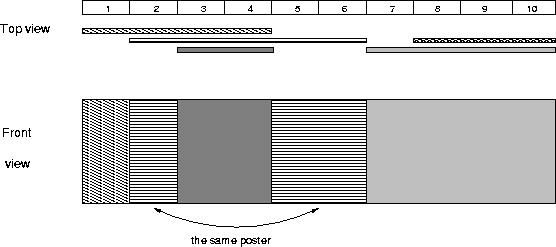POJ2528:Mayor's posters(线段树区间更新+离散化)
Description
- Every candidate can place exactly one poster on the wall.
- All posters are of the same height equal to the height of the wall; the width of a poster can be any integer number of bytes (byte is the unit of length in Bytetown).
- The wall is divided into segments and the width of each segment is one byte.
- Each poster must completely cover a contiguous number of wall segments.
They have built a wall 10000000 bytes long (such that there is enough place for all candidates). When the electoral campaign was restarted, the candidates were placing their posters on the wall and their posters differed widely in width. Moreover, the candidates started placing their posters on wall segments already occupied by other posters. Everyone in Bytetown was curious whose posters will be visible (entirely or in part) on the last day before elections.
Your task is to find the number of visible posters when all the posters are placed given the information about posters' size, their place and order of placement on the electoral wall.
Input
i and ri which are the number of the wall segment occupied by the left end and the right end of the i-th poster, respectively. We know that for each 1 <= i <= n, 1 <= l
i <= ri <= 10000000. After the i-th poster is placed, it entirely covers all wall segments numbered l
i, l
i+1 ,... , ri.
Output
The picture below illustrates the case of the sample input.

Sample Input
1
5
1 4
2 6
8 10
3 4
7 10
Sample Output
4
题意:给每个区间贴纸,后面贴的会覆盖前面贴的,问最后能看到的纸有几张
思路:很明显的线段树区间更新问题,但是由于数目大,所以我们要考虑离散化,由于之前没有弄过离散化,看了人家的代码,再加上自己的演草纸上模拟过程,终于弄懂了离散的原理。
首先,我们将区间存放在一个map数组之中,通过s的结构体,我们可以将每个点,与其相对应的区间序号整理起来,然后排序,为了方便判断,将左区间记为负数
通过S,我们重新将数据存入map数组之中,这次map数组存放的是他们位置的区间,由于n只有10000,所以位置最大也就只有10000位,如果存数值则要10000000的空间,泽阳无论在空间还有时间上都得到了优化
例如样例中输入后
排序:1,2,3,4,6,7,8,10
对应位置:1,2,3,4,5,6,7,8
这样我们可以看到,以位置来建树只需要8个空间,但是如果用数值大小来建树则需要10个空间,在当位置与数字的大小差很大的时候,存放位置能优化更多的时间与空间
而现在,map数组中存放的是
1,4
2,5
7,8
3,4
6,8
可以发现,这些位置所对应的数字便是原本题目给出的数字区间,所以我们最后只要求出这些位置覆盖后有几个可见即可
#include <stdio.h>
#include <string.h>
#include <algorithm>
using namespace std; int n,cnt;
const int maxn = 10000+10; struct node
{
int l,r,n;//n统计颜色
} a[maxn<<2]; struct kode
{
int point,num;//point记录区间的边,num记录位置
} s[maxn<<2]; int map[maxn<<1][2],ans,flag[maxn<<1]; int cmp(kode x,kode y)
{
return x.point<y.point;
} void init(int l,int r,int i)//建树
{
a[i].l = l;
a[i].r = r;
a[i].n = 0;
if(l!=r)
{
int mid = (l+r)>>1;
init(l,mid,2*i);
init(mid+1,r,2*i+1);
}
} void insert(int i,int l,int r,int m)
{
if(a[i].l == l && a[i].r == r)//找到了区间,更新这个区间的颜色
{
a[i].n = m;
return;
}
int mid = (a[i].l+a[i].r)>>1;
if(a[i].n>0)//重点注意,如果这个区间被访问了,并且这个区间有颜色,就要将这个区间的颜色更新到其左右孩子的节点,并且要将这个区间的颜色清空,这样才能算是覆盖
{
a[2*i].n = a[2*i+1].n = a[i].n;
a[i].n = 0;
}
if(l>=a[2*i+1].l)
insert(2*i+1,l,r,m);
else if(r<=a[2*i].r)
insert(2*i,l,r,m);
else
{
insert(2*i,l,mid,m);
insert(2*i+1,mid+1,r,m);
}
} void solve(int i)
{
if(a[i].n)//如果有这个区间有颜色了,马上停止访问并返回,因为下面的无论有没有颜色都是已经被覆盖的了
{
if(!flag[a[i].n])//乳沟有颜色且没被统计过的,就统计一次
{
ans++;
flag[a[i].n] = 1;
}
return;
}
solve(2*i);
solve(2*i+1);
return;
} int main()
{
int t,i,j;
scanf("%d",&t);
while(t--)
{
scanf("%d",&n);
for(i = 0; i<n; i++)//离散化
{
scanf("%d%d",&map[i][0],&map[i][1]);
s[2*i].point = map[i][0];
s[2*i+1].point = map[i][1];
s[2*i].num = -(i+1);
s[2*i+1].num = i+1;
}
sort(s,s+2*n,cmp);
int tmp = s[0].point,cnt = 1;
for(i = 0; i<2*n; i++)
{
if(tmp != s[i].point)//如果和前面的不同,这迭代加1
{
cnt++;
tmp = s[i].point;
}
if(s[i].num<0)
map[-s[i].num-1][0] = cnt;
else
map[s[i].num-1][1] = cnt;
}
init(1,cnt,1);
for(i = 0; i<n; i++)
insert(1,map[i][0],map[i][1],i+1);
memset(flag,0,sizeof(flag));
ans = 0;
solve(1);
printf("%d\n",ans);
} return 0;
}
POJ2528:Mayor's posters(线段树区间更新+离散化)的更多相关文章
- POJ 2528 Mayor's posters (线段树区间更新+离散化)
题目链接:http://poj.org/problem?id=2528 给你n块木板,每块木板有起始和终点,按顺序放置,问最终能看到几块木板. 很明显的线段树区间更新问题,每次放置木板就更新区间里的值 ...
- poj-----(2528)Mayor's posters(线段树区间更新及区间统计+离散化)
Mayor's posters Time Limit: 1000MS Memory Limit: 65536K Total Submissions: 43507 Accepted: 12693 ...
- POJ.2528 Mayor's posters (线段树 区间更新 区间查询 离散化)
POJ.2528 Mayor's posters (线段树 区间更新 区间查询 离散化) 题意分析 贴海报,新的海报能覆盖在旧的海报上面,最后贴完了,求问能看见几张海报. 最多有10000张海报,海报 ...
- poj2528 Mayor's posters(线段树区间修改+特殊离散化)
Description The citizens of Bytetown, AB, could not stand that the candidates in the mayoral electio ...
- poj 2528 Mayor's posters 线段树区间更新
Mayor's posters Time Limit: 1 Sec Memory Limit: 256 MB 题目连接 http://poj.org/problem?id=2528 Descript ...
- poj2528 Mayor's posters(线段树区间覆盖)
Mayor's posters Time Limit: 1000MS Memory Limit: 65536K Total Submissions: 50888 Accepted: 14737 ...
- POJ 2528 Mayor's posters (线段树+区间覆盖+离散化)
题意: 一共有n张海报, 按次序贴在墙上, 后贴的海报可以覆盖先贴的海报, 问一共有多少种海报出现过. 题解: 因为长度最大可以达到1e7, 但是最多只有2e4的区间个数,并且最后只是统计能看见的不同 ...
- POJ-2528 Mayor's posters (线段树区间更新+离散化)
题目分析:线段树区间更新+离散化 代码如下: # include<iostream> # include<cstdio> # include<queue> # in ...
- POJ-2528 Mayor's posters(线段树区间更新+离散化)
http://poj.org/problem?id=2528 https://www.luogu.org/problem/UVA10587 Description The citizens of By ...
随机推荐
- AngularJS Intellisense in Visual Studio 2012
Recently, a lot of people have asked for Intellisense support for AngularJS in the Visual Studio HTM ...
- ref:spring-data-XMLBean XXE复现分析
ref:https://blog.spoock.com/2018/05/16/cve-2018-1259/ 漏洞信息 看pivotal发布的漏洞信息如下 通过发布的漏洞信息可以知道,漏洞组件是在XML ...
- Python数据类型-列表(list)增删改查
1.添加元素 添加单个元素:使用append(object)函数可以为列表添加单个元素,参数object为对象:也就是说所有Python的对象都可以添加到列表中. 添加多个元素(合并列表):使用ext ...
- NEO4j简单入门
Neo4j是: 一个开源 无Schema 没有SQL 图形数据库 图形数据库也称为图形数据库管理系统或GDBMS. Neo4j的官方网站:http://www.neo4j.org Neo4j的优点 它 ...
- Java反射机制demo(二)—通过Class实例化任意类的对象
Java反射机制demo(二)—通过Class实例化任意类的对象 上一章节中,实例化了Class类对象的实例,这个部分的demo展示了如何使用Class对象的实例去获得其他类的对象的实例. 任意一个类 ...
- NetBIOS主机名扫描工具nbtscan
NetBIOS主机名扫描工具nbtscan NetBIOS主机名是NetBIOS协议为主机分配的名称.通过NetBIOS主机名,系统可以利用WINS服务.广播及Lmhost文件等多种模式将NetB ...
- NOIP2017 D2T1奶酪
这题终于是正经第一题感觉了. 只需要对相交或相切的球建一条边,然后对所有与底面有交点的球连边,再对所有与顶面有交点的球连边,bfs判断上下连通性即可. #include<iostream> ...
- DEDECMS最新友情链接getshell漏洞分析
先上exp: <?php //print_r($_SERVER); $referer = $_SERVER['HTTP_REFERER']; $dede_login = str_replace( ...
- java--由一道选择题研究数值越界
原题来自牛客网的java专项练习: 以下是代码. public class Test2 { public static void add(Byte b) { b=b++; } public stati ...
- Hive集合数据类型
Hive的列除了支持基本的数据类型外,还支持使用Struct.Map和Array三种集合数据类型. 假设某表有如下一行,我们用JSON格式来表示其数据结构.在Hive下访问的格式为 { "n ...
